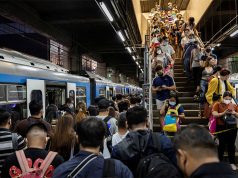
Photos and posts of complaints from passengers going through the new Parañaque Integrated Terminal Exchange or PITX are going rounds on social media after a few weeks since it opened.
The PITX, dubbed as the country’s first land port, was supposed to reduce traffic congestion at the south of Metro Manila, specifically in Parañaque and Pasay.
Since it opened on November 10, commuters from the South going to the greater part of Manila had to face longer trips than before with added travel costs at the terminal.
Commuter Jackie Salustiano shared her travel ordeal on Facebook. She wrote that many passengers from provincial buses of Cavite get stuck daily at the PITX due to the scarcity of city buses.
“Lahat ng bus mula Cavite ay required dumaan dito. Wala ng byaheng Baclaran dahil lahat ay dito na magbababa. Mas kumonti na ang bus na bumabyahe dahil hindi daw lahat kayang magbayad dito, pero patuloy ang pagbuhos ng pasahero,” Salustiano said.
To back up her story, she shared a photo of a high volume of passengers waiting for other public utility vehicles to take them to their destinations.
She further described how the PITX scheme made her daily commute inconvenient.
“Pagdating sa PITX, bumubuhos ang mga pasaherong ibinababa ng mga bus mula sa ibat-ibang lugar. Iisa lamang ang entrance. May bag check. Ang mga pasahero lahat nagmamadali. Pagpasok, either aakyat ka or bababa depende kung saan ang byahe mo,” Salustiano said.
Salustiano lamented she woke up at 3am with hopes of getting to work early, but still arrived late.
“Late ba akong gumising? Hindi. 3am gising na ako at 4:30 nag-aabang na ako ng masasakyan. Pero ang saklap. Late pa din,” she said.
Filipinos on Twitter also questioned the policy mandating all buses to pass by the PITX.
#PITX it is not appropriate that it will be a mandatory for all buses to pass by @ your terminal. Macapagal blvd is too small if all the buses are in there.. give alternate route.!!#southpeopleproblem#southpeoplebelike#changeyoursystem
— Joel Jerome Cabahug (@forever_jerome) December 2, 2018
The initial routes were made public via media sources and social media. The process itself, however, is not thoroughly explained, therefore causing public inconvenience instead.
Updates on the routes of the PITX can be viewed on its Facebook page and the page of the Department of Transportation.
The change of policies
Last September 13, the Land Transportation Franchising and Regulatory Board issued Memorandum Circular 2018-20 that states all PUVs plying from the southwest of Metro Manila to the Coastal Road and the Cavite Expressway are required to end their trips at the PITX. This was supposed to be effective since early October.
On November 21, the LTFRB issued another circular, Memorandum Circular No. 2018-022 or MC 22. Board member Aileen Lizada, however, dissented on it.
For Lizada, the new system will cause undue injury to the income of the affected bus operators.
Other board members then accused her of spreading “false and malicious allegations” to the press for releasing an unofficial copy of the memo. The document she sent to reporters was only a draft as it contained her opinion.
Lizada did not comment on it, rather, asked the body to focus on their work.
“We need to focus our attention in finding solutions sa mga concerns ng riding public,” she said.
Under MC 22, the following provincial buses bound to Metro Manila are exempted from ending their trips at the landport.
- Bulacan (north) – Bocaue, Meycauayan, Marilao, Obando, and San Jose del Monte City;
- Cavite (southwest) – Imus, Bacoor, Dasmariñas, General Trias, Silang, Kawit, Noveleta, and Cavite City; and
- Laguna (south) – San Pedro, Biñan, and Sta. Rosa City.
These buses, however, are still required to pass by the terminal to pick up passengers.
Buses beyond these areas, including those from Batangas (Nasugbu, Calatagan and Balayan) and long-haul Cavite routes, will still have to end at PITX.
This means commuters from these places have to make bus transfers to get in and out of the metropolis.
President Rodrigo Duterte inaugurated PITX on November 5. It was part of the government’s big infrastructure program and funded by the private MWM consortium (Megawide Construction Corporation and WM Property Management).









